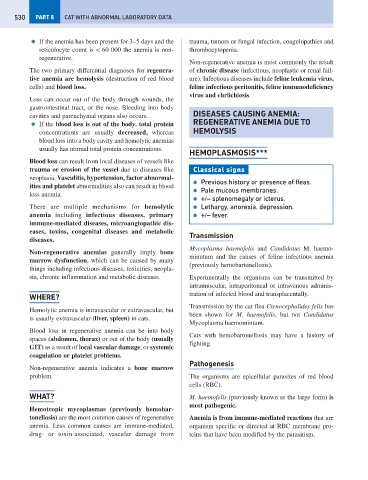Page 538 - Problem-Based Feline Medicine
P. 538
530 PART 8 CAT WITH ABNORMAL LABORATORY DATA
● If the anemia has been present for 3–5 days and the trauma, tumors or fungal infection, coagulopathies and
reticulocyte count is < 60 000 the anemia is non- thrombocytopenia.
regenerative.
Non-regenerative anemia is most commonly the result
The two primary differential diagnoses for regenera- of chronic disease (infectious, neoplastic or renal fail-
tive anemia are hemolysis (destruction of red blood ure). Infectious diseases include feline leukemia virus,
cells) and blood loss. feline infectious peritonitis, feline immunodeficiency
virus and ehrlichiosis.
Loss can occur out of the body through wounds, the
gastrointestinal tract, or the nose. Bleeding into body
cavities and parenchymal organs also occurs. DISEASES CAUSING ANEMIA:
● If the blood loss is out of the body, total protein REGENERATIVE ANEMIA DUE TO
concentrations are usually decreased, whereas HEMOLYSIS
blood loss into a body cavity and hemolytic anemias
usually has normal total protein concentrations.
HEMOPLASMOSIS***
Blood loss can result from local diseases of vessels like
trauma or erosion of the vessel due to diseases like Classical signs
neoplasia. Vasculitis, hypertension, factor abnormal-
● Previous history or presence of fleas.
ities and platelet abnormalities also can result in blood
● Pale mucous membranes.
loss anemia.
● +/- splenomegaly or icterus.
There are multiple mechanisms for hemolytic ● Lethargy, anorexia, depression.
anemia including infectious diseases, primary ● +/- fever.
immune-mediated diseases, microangiopathic dis-
eases, toxins, congenital diseases and metabolic
Transmission
diseases.
Mycoplasma haemofelis and Candidatus M. haemo-
Non-regenerative anemias generally imply bone
minutum and the causes of feline infectious anemia
marrow dysfunction, which can be caused by many
(previously hemobartonellosis).
things including infectious diseases, toxicities, neopla-
sia, chronic inflammation and metabolic diseases. Experimentally the organisms can be transmitted by
intramuscular, intraperitoneal or intravenous adminis-
tration of infected blood and transplacentally.
WHERE?
Transmission by the cat flea Ctenocephalides felis has
Hemolytic anemia is intravascular or extravascular, but
been shown for M. haemofelis, but not Candidatus
is usually extravascular (liver, spleen) in cats.
Mycoplasma haemomintum.
Blood loss in regenerative anemia can be into body
Cats with hemobartonellosis may have a history of
spaces (abdomen, thorax) or out of the body (usually
fighting.
GIT) as a result of local vascular damage, or systemic
coagulation or platelet problems.
Pathogenesis
Non-regenerative anemia indicates a bone marrow
problem. The organisms are epicellular parasites of red blood
cells (RBC).
WHAT? M. haemofelis (previously known as the large form) is
most pathogenic.
Hemotropic mycoplasmas (previously hemobar-
tonellosis) are the most common causes of regenerative Anemia is from immune-mediated reactions that are
anemia. Less common causes are immune-mediated, organism specific or directed at RBC membrane pro-
drug- or toxin-associated, vascular damage from teins that have been modified by the parasitism.

